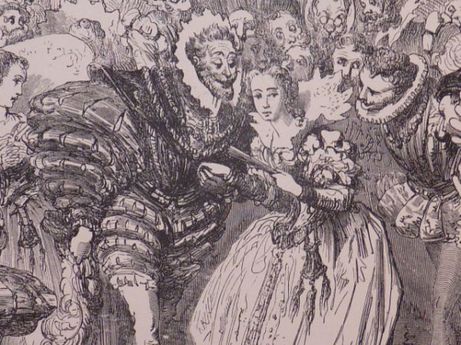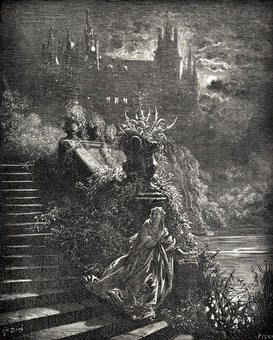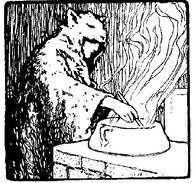|
Ditu Migniulellu, a tale from Corsica, is utterly unique. I have never seen any other story combine elements of Cinderella with Thumbling like this. However, as I started studying it, I started seeing layers that I had missed entirely on the first read. For one thing, I never realized that it’s a variant of Donkeyskin. Donkeyskin (AT 510B) is similar to Cinderella (AT 510B), but the typical elements go something like this:
Incidentally, the first recorded versions of Donkeyskin appeared in France and Italy – and guess where Corsica is. The story starts out typically for a thumbling tale, with a woman who's sad because she has no children. In the older French version by Ortoli, the woman is promised a child by a voice from the roof. Ruth Manning-Sanders' English translation has a more involved version where the woman encounters a fairy of the stream, who gives her a white berry to eat. One way or another, the woman has a baby who’s no bigger than her finger, and four fairies appear to give christening gifts. They give the baby the name Ditu Migniulellu, or Little Finger. She receives beauty, a beautiful singing voice, and the ability to speak. The first of the fairies promises to come whenever D. M. needs her. When Ditu Migniulellu is sixteen, she’s still the same size and her mother has come to resent and then to hate her. Out in the garden, she traps her beneath a pot and leaves her there. At first D.M. protests, but then she decides to be patient and starts to sing. The prince just happens to be passing by, and is amazed by the beauty of her voice. Rashly, he swears to marry the singer. Ditu shares her beautiful singing voice with characters like Sleeping Beauty, Rapunzel, and Thumbelina. Singing was a valuable talent and good way for entertainment, and a trait deserving of high esteem, says SurLaLune. And it’s her voice which first attracts the prince. However, the scene that follows tells us a lot about where this story is going. She sings to guide him to her hiding place, but he becomes enraged when he can’t find her. He kicks the pot and shatters it. Which probably could have killed her, but she’s okay. Now honor-bound to marry her, he carries her home in his pocket. She calls out that she’s suffocating and so he carries her the rest of the way in his hand. As soon as they reach the palace, he introduces her to the queen, who is not impressed. He admits that he’s not a fan of this development either, but he must keep his promise. I love Ortoli’s version, even through the haze of Google Translate, because the queen says something like, “Keep her, she won’t take up too much space.” So far, the story has started out as a Thumbling tale, and then very briefly gone through a typical Cinderella phase with the cruel mother figure. From this point on, it is very clearly Donkeyskin. Bored by his tiny fiancée, the prince decides to throw a three-night-long ball, where he can enjoy himself with all of the most beautiful women in the kingdom. (This is softened in Manning-Sanders, where the ball is the queen’s initiative, as she hopes to distract him from his promise.) Ditu Migniulellu begs the prince to allow her to go to the ball, but he rebukes her and slaps her. After she runs to her room crying, her godmother appears. She transforms D.M. into a beautiful girl of normal stature, wearing a beautiful silk dress. She rides to the ball in a carriage drawn by butterflies (ponies in Manning-Sanders). At the ball, the prince is smitten with the transformed D.M. Teasingly, she tells him that she hails from the Kingdom of Slap, and then escapes in her tiny form. We’re going to get into this more later. The next night is an exact repeat. He kicks her with his spur, and in rose-colored silk she announces that she’s from the Kingdom of Spur. However, he also proposes to her and gives her a ring. She asks if he’s already promised to Ditu Migniulellu, but he glosses over it. From Manning-Sanders’ version:
WHAT A CHARMER. The disguised D. M. excuses herself. On the third night, her dress is blue (rainbow in Manning-Sanders) decorated with gold and diamonds, and she’s from the Kingdom of Whip, first one to guess why wins a prize. Once more she escapes, despite all his best plans, and the heartsick prince takes ill and is confined to bed. As herself, Ditu Migniulellu enters his room and tells him that she’ll make him a cake, and if he eats it, he’ll find the maiden he seeks. After some cajoling, he agrees (with the addendum that he’ll kill her if she’s trying to trick him). When she makes the cake, she slips into it the ring that he gave her at the ball. He’s delighted to find it. Then D.M., transformed and beautiful once more, stands before him, and the truth comes out. They get married and live happily ever after. She doesn’t really seem to care about his past behavior, but Manning-Sanders has the fairy godmother say a bit pointedly, “Since she loves you, she shall be yours, little as you deserve her.” Ortoli's version cracks me up here, because the prince’s most pressing question is “Can you still sing?” And then the narrator arrives too late to the wedding and is put under the table “where I received only kicks and bones. As for you, what did you do that day?” Personally, I kind of like D.M., because she has this characteristic that she never. Shuts. Up. She’s constantly chattering and singing and it seems like everybody is pretty annoyed by her. When she’s at the ball, though, she’s much more quiet and dignified. As for her prince, he is an incredibly shallow figure. He is enamored by her beautiful singing voice, and then equally repulsed by her initial appearance. Then he is so smitten with her beautiful appearance that he wishes to die if he can’t have her. His behavior towards her is uniformly horrible. When she’s in her small, despised form, he constantly scolds her for her chattering and tells her to shut up, physically attacks her, and threatens to kill her. He shows a tendency to lash out in anger against things around him like the flowerpot. In her version, Manning-Sanders tones down his threats and displaces some of his behavior (like outright planning the ball to meet other women) onto the mother. However, he is still stand-out awful. Ditu Migniulellu is different from the other variants of Donkeyskin. Like them, she is perceived as lowly and less than human. However, her appearance is not a disguise. At least, not one that she chose for herself. In this she’s more akin to the enchanted animal bride figures like Doll i’ the Grass. She is not a servant in the royal household; she is brought there as a fiancée. She never has to go through the cycle of hard physical labor. She also has a fairy godmother who gives her the dresses – an element much closer to Cinderella. Donkeyskin variants usually come up with their own dresses. In most Donkeyskin stories, the story begins with the heroine fleeing her father who wants to marry her. In Ditu Migniulellu’s case, she leaves behind a hateful mother figure who resents her and tries to imprison her. Rather than running away in disguise, like Donkeyskin, she is rescued. But once again she ends up in a situation where she is still unwanted and despised, as well as abused by the man she’s supposed to marry. Manning-Sanders’ version moves some of the blame onto the prince’s mother, but he’s still a colossal jerk. When I first read this story I was mystified by its cruel yet apparently desirable prince. Then I started reading other versions of Donkeyskin and finally found the pattern. In many versions, the love interest is physically and verbally abusive – throwing items and sometimes revealing her identity by roughly tearing off her disguise. The German Allerleirauh, or All-kinds-of-fur, had the king hurling his boots at her head. The Brothers Grimm cut this out, but allusions to it still remain within the fairytale. When I found D. L. Ashliman's site, I was saying “OHHH!” the entire time, because Ditu Migniulellu’s hints at her identity finally made a lot more sense. When the heroine appears at the ball and he asks her where she’s from, she makes up names that allude to the injuries – as in “Broomthrow, Brushthrow, Combthrow” – or in “Fair Maria Wood,” she tells him that she is from “that country that when they speak of going to a ball they are beaten on the head.” Hinty hint hint! She’s telling him that she’s from right there in his household. He doesn’t pick up on it. Fortunately, not all variants of Donkeyskin have this element. In many, the prince is kind. But why is this element of the abusive prince so widespread? Are we really supposed to cheer when they get married? One of my thoughts is that it comes from older, more accepting attitudes surrounding spousal abuse in history. But why doesn’t she just tell him who she is? Perhaps it’s a sort of test, or she’s shy. In Ditu Migniulellu, I think it’s a relic of older variants, where this element makes sense; there, due to her trauma after dealing with her father, she’s simply not ready. Others have written really in-depth on these themes.
Ditu Migniulellu clings to her prince out of a need for protection. Cruel he may be, but she needs the status and safety of marriage. She also clings to him, I think, because she is starved for affection she never got from her resentful mother. When the prince starts to renege on his promise to marry her, she dons an alternate identity to regain his attention. What strikes me most about this story is just what Ashliman pointed out—that in so many versions, she flees from one abusive situation to another. The father and husband are mirrors of each other and in many cases it’s easy to confuse them. But when you think about real life, there is a kind of answer, and a very tragic one. As Jeana Jorgensen points out, “The transition from an abusive parent to an abusive spouse, repeatedly found in ATU 510B, is reminiscent of a real-life pattern observed by therapists and caseworkers.” An interesting note from Tatar in The Hard Facts of the Grimms’ Fairy Tales: Cinderella tales have the cruel mother figure, while Donkeyskin tales have the perverted father figure. “A stepmother’s insufficient love and a father’s excessive love for a child appear to be incompatible” (149). These are usually mutually exclusive in fairytales but actually seem to dovetail really well – the father’s behavior explains the mother’s, says Tatar. Ashliman says, “This is not a story of happiness and fulfillment, but rather one of coping and surviving.” I initially thought Ditu Migniulellu was a silly and shallow tale, but it actually comes from two long traditions of folktales and has a bit of a mashup feel to it. The cruel prince that disturbed and mystified me is inherited from Donkeyskin, D.M.'s literary mother. It's a dark and disturbing history, but at the moment, I feel like I've answered a question that's bothered me ever since I cracked open the first page of this fairytale. SOURCES AND FURTHER READING
Text copyright © Writing in Margins, All Rights Reserved
0 Comments
Leave a Reply. |
About
Researching folktales and fairies, with a focus on common tale types. Archives
July 2024
Categories
All
|
Writing in Margins



 RSS Feed
RSS Feed
